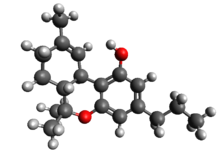Tetrahydrocannabivarin
 |
|
 |
|
| Clinical data | |
|---|---|
| Routes of administration |
Oral, Smoked, Inhaled |
| ATC code | none |
| Legal status | |
| Legal status |
|
| Identifiers | |
|
|
| CAS Number |
28172-17-0 |
| PubChem (CID) | 34180 |
| IUPHAR/BPS | 6418 |
| ChemSpider |
31500 |
| UNII |
I5YE3I47D8 |
| Chemical and physical data | |
| Formula | C19H26O2 |
| Molar mass | 286.41 g/mol |
| 3D model (Jmol) | Interactive image |
|
|
|
|
|
|
|
Tetrahydrocannabivarin (THCV, THV) is a homologue of tetrahydrocannabinol (THC) having a propyl (3-carbon) side chain instead of a pentyl (5-carbon) group on the molecule, which makes it produce very different effects from THC. This terpeno-phenolic compound is found naturally in Cannabis, sometimes in significant amounts. The psychoactive effects of THCV in Cannabis preparations are not well characterized.
Similarly to THC, THCV has 7 double bond isomers and 30 stereoisomers (see: Tetrahydrocannabinol#Isomerism). Its melting point is < 220 degrees Celsius, < 428 degrees Fahrenheit.
Plants with elevated levels of propyl cannabinoids (including THCV) have been found in populations of Cannabis sativa L. ssp. indica (= Cannabis indica Lam.) from China, India, Nepal, Thailand, Afghanistan, and Pakistan, as well as southern and western Africa. THCV levels up to 53.7% of total cannabinoids have been reported.
THCV is a cannabinoid receptor type 1 antagonist and cannabinoid receptor type 2 partial agonist. Δ8-THCV has also been shown to be a CB1 antagonist. Both papers describing the antagonistic properties of THCV were demonstrated in murine models.
Unlike THC, cannabidiol (CBD), and cannabichromene (CBC), THCV doesn’t begin as cannabigerolic acid (CBGA). Instead of combining with olivetolic acid to create CBGA, geranyl pyrophosphate joins with divarinolic acid, which has 2 less carbon atoms. The result is cannabigerovarin acid (CBGVA). Once CBGVA is created, the process continues exactly the same as it would for THC. CBGVA is broken down to tetrahydrocannabivarin carboxylic acid (THCVA) by the enzyme THCV synthase. At that point, THCVA can be decarboxylated with heat or UV light to create THCV.
...
Wikipedia
